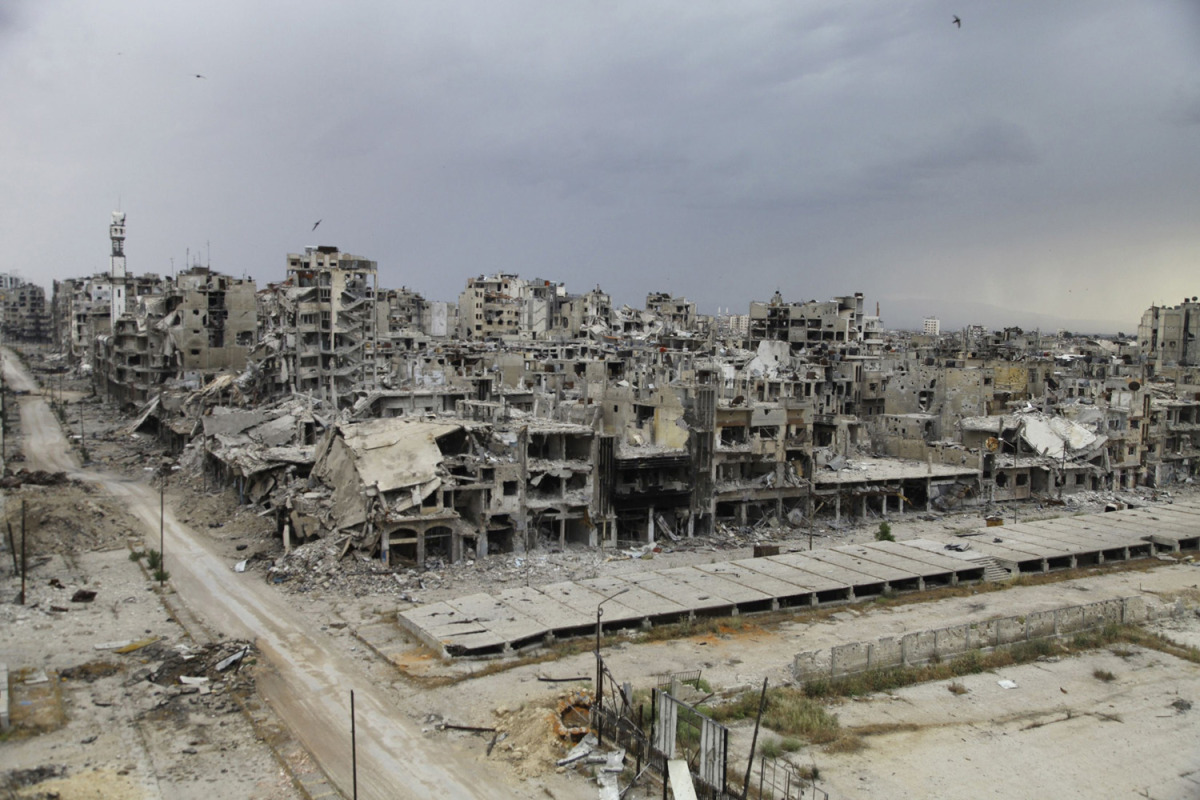Walter Benjamin once remarked that “Allegories are, in the realm of thoughts, what ruins are in the realm of things.” The reverse also holds: ruins are, in the realm of things, what allegories are in the realm of thoughts. Either way, the expectation is that a message can be found where there remains only a trace of the original medium, structure, or civilization. Even though both ruins and allegories signify the loss, fallibility, and futility of communication, there is at the same time a suggestion that meaning remains just beyond the other side of representation, and the hope that some connection might be made across the divide between past and present, image and idea, cosmology and history. . . . But then we come to this.
I am staggered by this photograph from Homs. Nor is it the first witness to the terrible destruction of lives and infrastructure in the Syrian civil war. All wars are terrible, but this one seems to have made the cities themselves the primary targets. Many cities have been bombed over the past 100 years, but usually for what they housed. In Homs and Aleppo, the city itself–as an organic, living thing with autonomy and purpose–is being tortured to death.
I’ve written before about Rubble World, that swath of destruction that war is spreading the globe, and Syria already had become one of the most disturbing examples of this slow-moving catastrophe. Since then the death toll and range of destructiveness has continued to increase in Syria and elsewhere. Of course, buildings can be rebuilt, streets repaved, and no one can say how Syria will be doing in fifty years. But even if the equivalent of a Marshall Plan were in the works–and it is not–something about the present has already been revealed.
What we may have before us in this remarkable photograph is a new order of ruins. These are ruins without nobility, as they have not been made by the passing of time, nor will they be able to withstand it. They are without any secondary value: too dangerous to provide sanctuary from a summer shower, too hideous to be the backdrop for romance or any other idle pleasure. Where the buildings might have provided an empathic connection with those living there before, instead there is only a twisted warren of barren concrete and industrial filth. This wreckage demeans memory itself.
These ruins may be different in another sense as well. Instead of marking the presence of an extinct civilization, they may foretell the demise of our own. A new order of ruins suggests a new order of war and peace, investment and abandonment, indifference and self-interest, prosperity and brutality. If this image is representative, we also can assume that the new order is not one in which mercy is a consideration. Where total war used to be thought of as the ultimate expression of great power conflict, now it appears more like a niche predator, and God help you if you live in that niche.
The new ruin is a photographic artifact, and good thing too, as we would not see it otherwise. Like photography generally, this ruin can suggest how alternate futures already exist in the present, albeit as merely possible paths for social advancement, sustainability, or decline. Consider what else is evident in that regard: for example, I see a world with more weapons than water, more displacement than stability, more terror than peace. For most of us, these possibilities still are on the other side of the divide between present and future. But to follow the allegory, the traces of the future are already here, waiting for us to see them. To see, that is, how modernity is already in ruins.
Photograph by Ghassan Najjar/Reuters.

[…] Creative Destruction in Homs: The New Order of Ruins (No Caption Needed) […]
[…] Creative Destruction in Homs: The New Order of Ruins (No Caption Needed) […]
[…] Creative Destruction in Homs: The New Order of Ruins (No Caption Needed) […]
[…] Creative Destruction in Homs: The New Order of Ruins (No Caption Needed) […]